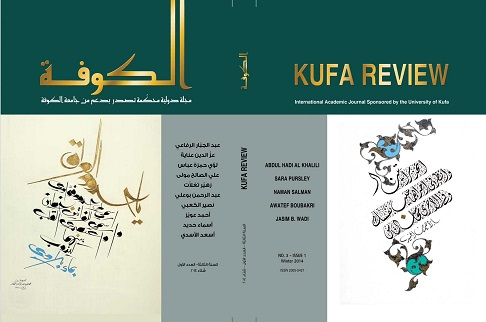
Vol. 5 No. 3 (2014): Kufa Review | مجلة الكوفة

In this first issue of the third year, Kufa Review moves forward to combine many shades and colors of intellectual research: epistemological, historical, documentary, biographic, philosophical, and literary, which are unified by their diversity to introduce this issue. Abd al-Jabbar al-Rifai continues his critique of contemporary Iranian thought and presents another research, “Hossein Nasr: the body is for the West and the spirit is for the East.” Nasr represents another voice of religious thinking, in addition to the four voices al-Rifai presented in previous issues. The article presents the biography of Nasr and his thought against a background made of the various schools of contemporary Iranian thought, and the influences of many Western scholars on him, those who devoted their work to the East and some of them converted to Islam. “The Soviet Union collapsed and the Vatican continues to exist.” This phrase stands at the core of the paper by Ezzeddine Anaya, “The Catholic Church and Human Rights,” and stands as a reply to a sarcastic remark Stalin once made against the church. As the phrase suggests, the paper aims primarily to identify the Catholic understanding of human rights and the importance of the paper stems from the dire need to attain precise knowledge in the Arabic culture about these aspects of Christianity, which remained subject to distortion and rushed judgment. Here, we encounter the most important historical milestones in the church’s dealing with human rights. Autobiography is also present in this issue. Luay Hamza Abbas writes about the “Writing of autobiography: aims and techniques.” It is certain that this research is not without imagination, since the author is a story writer and the texts he worked on remain n the domain of imagination. And this is related to the article by Ali al-Salih Moula, “The book burning: a research on targeting memory.” As Luay H. Abbas studies the techniques of autobiography, and everyone who writes his autobiography is looking for being eternal, the work of Moula examines the ways of burning books and destroying them. Book burning, according to the author, used to be a spectacle and a form of celebration, where people are invited and the acts took place in a public square. If the aim of the authorities, from this act, is to send a message, it is certainly the same aim from conducting public executions. In an academic research titled, “The Ibadhi sect between the manuscript of ‘Risalat al-Firaq’ and some other sectology books,” Zhayyir Taghillat examines the portraying of the Ibadhi sect in the ‘Risalat al-Firaq’ by Abu Amr Uthman b. Khalifa al-Marghani al-Sufi as compared with the contents of other, and older books, of this genre, especially in the enumeration and identification of Ibadhi sub-sects. The article by Naseer al-Ka’bi, “the Tablet of Christian-Arab Writing,” differs from others in that it relied on the recent material discoveries that were found by the excavation mission in 2010-2011, while other studies relied on the literary sources both Islamic and Syriac. Abderrahmane Bouali examines the issue of intertextuality and intertext, which are among the basic concepts and terms that preoccupied the contemporary critics and theorists. Then we move to the paper by Ahmed Uwayyiz on the Western hermeneutic mind is an epistemic journey in the process of forming an epistemic system in the Western hermeneutic mind that contributed to forming its worldview. The issue’s conclusion is titled “The Architecture of Deconstruction Writes the World,” by Architect As’ad al-Asadi. Architecture, like writing, witnesses renewal and transformation. It is a text of some sort and it can be deconstructed and reconstructed in a new light that transcends the form to the mind. In the English section, Sara Pursley studies the concepts of nation, gender, and time in Jawad Selim’s Monument to Freedom. She presents an excellent account of the history of the monument, its significance, and an analysis of its components, and how all of this relates to the Iraqi cultural debate in the past decades. From this to the early Islamic era, Dr. Andul Hadi al-Khalili, a prominent Iraq neurosurgeon, analyses the historical accounts of the assassination of Imam Ali b. Abi Talib, Prophet Muhammed’s cousin and the first Shi’a Imam, to determine the medical causes of his death, concluding that it was the poison on the sword that caused the death, not the damage caused by the strike to the brain. In addition to its novelty – medically analyzing a death from 1400 years ago – the study has many theological and historical implications that must be considered. Jasim Wadi studies “the political philosophy of friendship in Iraqi political theory.” He analyzes examples from ancient Iraq, such as the depiction of friendship in the Epic of Gilgamish and moves to more modern forms of friendship patterns, depending on the status of each side in the friendship equation. In her article on the representations of Arabic and Islamic identity in 9/11 novel, Awatef Boubakri examines the ways ascribed identity is formed in a novel titled “Adams Harbor, and shows how the author, and others like him, try to manufacture stereotypes of Arabs and Muslims and generalize the negative aspects of selected personalities to portray all Arabs and Muslims in a negative image. Finally, Naman Salman writes an article on the Theology of Tanzih in the Mu’tazila thought. This is one of the most controversial theological debates among the various Islamic schools of theology and their central figures, who advocated differing views on God’s Essence and Attributes. In his well-written study, the author walks his readers through this theological minefield with excellent skill and knowledge. We proudly present to our readers another issue of Kufa Review, with the usual combination of timeliness, solid standards, and free-thinking, and call on all our colleagues to continue supporting this effort with excellent research and highly needed feedback.

 Abstract View: 84
,
Abstract View: 84
,